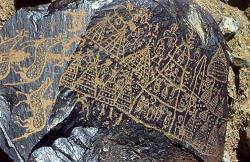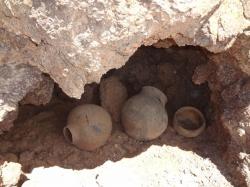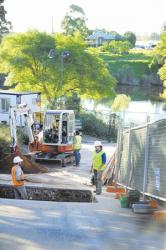INSTITUT SUPERIEUR D'ANTHROPOLOGIE
INSTITUTE OF ANTHROPOLOGY
ONLINE COURSES / COURS A DISTANCE
INSCRIPTION 2012 / Session III : Juillet 2012
REGISTRATION 2012 / Term III : July 2012
CHINE –  – Yinshan Mountains - Eighteen cliff paintings dating back over 4,000 years have been discovered by archaeologists in northern China's Inner Mongolia Autonomous Region, an official said Sunday. The prehistoric portraits were unearthed in the Yinshan Mountains in Urad Middle Banner (an administration division of the Inner Mongolia Autonomous Region), said Liu Binjie, head of the Cultural Relics Bureau of Urad Middle Banner. The patterns are still clear and the paintings have been arranged in an orderly manner on the cliffs. Liu added that they are the finest of their kind that have been unearthed so far. Among the paintings, seven faces were exaggerated and monstrous, and have been interpreted as the seven stars of the "Big Dipper" constellation. Liu concluded that these may have been drawn by prehistoric men for worship. So far, over 10,000 ancient cliff paintings have been discovered in the Yinshan Mountains, according to the archaeologists. Liu said paintings of faces found on Yinshan Mountains cliffs are similar to those in the Helan Mountains, located on the boundary between Ningxia and Inner Mongolia. They are also similar to those in eastern Russia, showing close connections with ancient peoples' migration patterns, and sacrificial and worship ceremonies. They are very precious materials for the research on prehistorical life, said Liu. Local government and relevant departments have made efforts to protect the cliff paintings in this area, including restrictions on grazing and the installation of monitoring equipment.
– Yinshan Mountains - Eighteen cliff paintings dating back over 4,000 years have been discovered by archaeologists in northern China's Inner Mongolia Autonomous Region, an official said Sunday. The prehistoric portraits were unearthed in the Yinshan Mountains in Urad Middle Banner (an administration division of the Inner Mongolia Autonomous Region), said Liu Binjie, head of the Cultural Relics Bureau of Urad Middle Banner. The patterns are still clear and the paintings have been arranged in an orderly manner on the cliffs. Liu added that they are the finest of their kind that have been unearthed so far. Among the paintings, seven faces were exaggerated and monstrous, and have been interpreted as the seven stars of the "Big Dipper" constellation. Liu concluded that these may have been drawn by prehistoric men for worship. So far, over 10,000 ancient cliff paintings have been discovered in the Yinshan Mountains, according to the archaeologists. Liu said paintings of faces found on Yinshan Mountains cliffs are similar to those in the Helan Mountains, located on the boundary between Ningxia and Inner Mongolia. They are also similar to those in eastern Russia, showing close connections with ancient peoples' migration patterns, and sacrificial and worship ceremonies. They are very precious materials for the research on prehistorical life, said Liu. Local government and relevant departments have made efforts to protect the cliff paintings in this area, including restrictions on grazing and the installation of monitoring equipment.
http://www.kaogu.cn/en/detail.asp?ProductID=3452
USA –  Tucson - Tucson Sector Border Patrol agents have discovered two sets of archaeological artifacts in the Organ Pipe Cactus National Monument since February. In late February, Ajo Station agents patrolling on foot came across what they believed to be an ancient bowl hidden in a shady outcropping of rock, the Border Patrol said. Officials from the Organ Pipe Cactus National Monument were notified and identified the clay vessel as an olla, an ancient pot that was used to hold water and was stored in shade to keep the water cool, the Border Patrol said. Agents patrolling in the same mountains in March discovered a second site with similar artifacts that were hidden in the entrance of a cave. Baiza said Wednesday that the pots were prehistoric and ancestral to the Tohono O'odham, but have yet to be dated. The artifacts are now with the Western Archaeological and Conservation Center in Tucson where a ceramics curator will evaluate and catalog them. They will be stored at WACC for preservation, Baiza said.
Tucson - Tucson Sector Border Patrol agents have discovered two sets of archaeological artifacts in the Organ Pipe Cactus National Monument since February. In late February, Ajo Station agents patrolling on foot came across what they believed to be an ancient bowl hidden in a shady outcropping of rock, the Border Patrol said. Officials from the Organ Pipe Cactus National Monument were notified and identified the clay vessel as an olla, an ancient pot that was used to hold water and was stored in shade to keep the water cool, the Border Patrol said. Agents patrolling in the same mountains in March discovered a second site with similar artifacts that were hidden in the entrance of a cave. Baiza said Wednesday that the pots were prehistoric and ancestral to the Tohono O'odham, but have yet to be dated. The artifacts are now with the Western Archaeological and Conservation Center in Tucson where a ceramics curator will evaluate and catalog them. They will be stored at WACC for preservation, Baiza said.
http://www.tucsonsentinel.com/local/report/050812_borderpatrol_artifacts/agents-discover-archaeological-artifacts-west-tucson/
USA –  St Augustine - A hole in the ground in the garden courtyard of a building on Hypolita Street is telling more of St. Augustine’s story. “Even in a small pit you can learn a lot about St. Augustine,” City Archaeologist Carl Halbirt said Wednesday of the dig that began eight days ago. Volunteer Janet Jordan was kneeling in the more than four feet deep hole, using a spade to scoop the dirt into buckets that Halbirt then screened for findings, picking out shell and animal fragments and both Native American and Spanish pottery shards. None of the items predates 1650, and that backs up the hypothesis that Hypolita Street was probably the northern boundary of St. Augustine in 1650. While digging the 5-by-6-foot pit, Halbirt found evidence of an impermanent wood structure after uncovering a builder’s trench with the stains of four wooden posts visible in the soil. Based on ceramic evidence, the builder’s trench dates to sometime between the late 1600s and early 1700s, Halbirt said, and that, combined with findings from other digs in the area, backs up his theory. According to one map, the wooden structure was on property that included a house of stone belonging to Agustina Rexidor. The house would have been 400 to 500 feet from a wooden fort that was the city’s defense before the building of the more solid Castillo de San Marcos. The area between the house and fort would have been open, the field of fire soldiers needed to protect the fort in case of attack.
St Augustine - A hole in the ground in the garden courtyard of a building on Hypolita Street is telling more of St. Augustine’s story. “Even in a small pit you can learn a lot about St. Augustine,” City Archaeologist Carl Halbirt said Wednesday of the dig that began eight days ago. Volunteer Janet Jordan was kneeling in the more than four feet deep hole, using a spade to scoop the dirt into buckets that Halbirt then screened for findings, picking out shell and animal fragments and both Native American and Spanish pottery shards. None of the items predates 1650, and that backs up the hypothesis that Hypolita Street was probably the northern boundary of St. Augustine in 1650. While digging the 5-by-6-foot pit, Halbirt found evidence of an impermanent wood structure after uncovering a builder’s trench with the stains of four wooden posts visible in the soil. Based on ceramic evidence, the builder’s trench dates to sometime between the late 1600s and early 1700s, Halbirt said, and that, combined with findings from other digs in the area, backs up his theory. According to one map, the wooden structure was on property that included a house of stone belonging to Agustina Rexidor. The house would have been 400 to 500 feet from a wooden fort that was the city’s defense before the building of the more solid Castillo de San Marcos. The area between the house and fort would have been open, the field of fire soldiers needed to protect the fort in case of attack.
http://staugustine.com/news/local-news/2012-05-09/dig-blue-max-authors-home-hints-citys-original-northern-border#.T6vmzus5JvA
AUSTRALIE –  Windsor - Aboriginal tools and colonial-era artefacts including ceramics have been unearthed on both sides of the Hawkesbury River by two teams of archaeologists working on sites where the new Windsor bridge would be built if the proposed Option One plan goes ahead. If the items found are judged to be of historical significance it could call into question the entire development, or at the very least significantly slow it down. But local historian Jan Barkley-Jack who followed the excavations on what is now the Hawkesbury Regional Museum claims the digs are literally just scratching the surface. Artefacts recovered so far – which include colonial-era iron nails, ceramics and charcoal, as well as Aboriginal tools – will now be studied in detail by other experts to establish their historical significance.
Windsor - Aboriginal tools and colonial-era artefacts including ceramics have been unearthed on both sides of the Hawkesbury River by two teams of archaeologists working on sites where the new Windsor bridge would be built if the proposed Option One plan goes ahead. If the items found are judged to be of historical significance it could call into question the entire development, or at the very least significantly slow it down. But local historian Jan Barkley-Jack who followed the excavations on what is now the Hawkesbury Regional Museum claims the digs are literally just scratching the surface. Artefacts recovered so far – which include colonial-era iron nails, ceramics and charcoal, as well as Aboriginal tools – will now be studied in detail by other experts to establish their historical significance.
http://www.hawkesburygazette.com.au/news/local/news/general/artefacts-found-windsor-bridge-progress-may-come-to-grinding-halt/2551307.aspx
CHINE – Nanjing - Italian sports car maker Ferrari has apologised after one of its cars drove on an ancient Chinese monument, prior to a publicity event, causing damage. The car was filmed wheel-spinning on top of a 600-year-old Ming-dynasty era wall in the city of Nanjing. Footage of the screeching vehicle has infuriated China's online community, hitting a nerve in a society where such cars are a symbol of privilege. One web user called it a "rude insult" to Chinese tradition and culture. The incident, in the run-up to a Ferrari show, left tyre marks on the wall. The BBC's John Sudworth in Shanghai says that other than the tyre marks, physical damage to the monument does not appear to be substantial
http://www.bbc.co.uk/news/world-asia-china-18006291
INDE – Ghiladevi Chowk - A search to recover stolen water meters in Kalyan led cops to chance upon some historic antique stationery lying in a scrap shop. On Tuesday, the Bazarpeth police recovered atamrapatra - a copper-plate used to record information by engraving in ancient times - said to be dating back to 1019 AD, from a scrap shop in Ghiladevi Chowk, Kalyan (West). It has been sent to the archaeology department for assessment. The new discovery weighs 5.5 kilogram, and has three sheets with inscriptions in the Devnagri script, mostly Sanskrit. Yesterday, police called archaeology officials who took photographs of the find, and will submit a report soon.
http://www.ndtv.com/article/cities/hunt-for-stolen-water-meters-leads-cops-to-1-000-yr-old-scripture-206301